|
Our
team is investigating the Molidae through two complementary approaches–pop-off
satellite archival tagging of individuals and genetic analysis
of global populations.
Select a topic below to read more...
TAGGING
Our tagging work involves
special tags called pop-up archival transmitting (PAT) tags.
PAT tags are secured using a plastic anchor inserted at the posterior
base of the dorsal fin. While attached, the tag records and logs
temperature, depth and light intensity. From light intensity,
day length and local noon are calculated. This information in
conjunction with sea surface temperature measurements is used
to document location. After a pre-programmed time, the tag releases
floats to the surface and uploads its data to satellite. Thus,
daily information on movements and behaviors are obtained without
having to relocate either the fish or tag. Should the tag release
early or the fish die and sink, the satellite tag will automatically
surface and initiate transmission. (For more information on
satellite tags see http://www.wildlifecomputers.com/
Satellite%20Tags/PAT.htm) Our team has tagged Mola mola off San
Diego (California), Capetown (South Africa), Kamogawa (Japan)
and Queensland (Australia).
We have also tagged Masturus lanceolatus off
Hua Lien (Taiwan).
To date, six tags have reported and we are
in the midst of analyzing our data. We’ll be posting our
exciting results soon so stay tuned. The sunfish have some
dark secrets to divulge.
The mola team recently returned from a successful
tagging trip to Japan where 2 more tags were deployed on Mola
mola with the help of the Kamogawa SeaWorld and the Fisheries
Cooperative Association of Kamogawa. These tags are due to
release on Halloween 2003. Whilst over in Japan, the team also
discovered a 1996 record of a Japanese Mola mola that appears
to be a new world record! Check out: http://news.nationalgeographic.com
/news/2003/05/0513_030513_sunfish.html.
The mola team is also planning to tag more sunfish this July
and August off the coast of California. And come December,
theyll be heading to South Africa.
GENETICS
Hundreds of
tissue samples have been analyzed from mola populations spanning
the globe. Some striking differences between certain populations
are emerging. We may even have two new species of giant ocean
sunfish. So stay tuned on the genetics front as well.
COMMERCIAL IMPORTANCE
and EDIBILITY
While unpopular in
Europe and the United States, molas are eaten throughout
Asia. Taiwan and Japan are the largest markets. All parts
of the mola are eaten including the skin, fin muscles, backbone,
testes, and gut which is viewed as a delicacy. In Taiwan,
the gut is served as "Dragon Intestines."
 Fish
Scientist Humor - YouTube Fish
Scientist Humor - YouTube
Unlike their pufferfish relatives, e.g. Fugu, molas
do not carry the deadly neurotoxin, tetratrodotoxin
(Saito et al 1991).
BYCATCH
Mola mola is the most
common bycatch of the drift net fishery, which targets broadbill
swordfish of California and Oregon. According to reports from
the National Marine Fisheries Society Southwest Region, between
1990-1998, 26.1% of the drift net catch consisted of the common
mola, which translates to a catch of 26,503 individuals. 42.1%
of the total discards were mola (Rand Rasmussen, pers comm).
In the Spanish driftnet swordfish fishery
on the Mediterranean side of the Gibraltar Straits, Mola
mola constituted 71% of the entire catch in 1992, 93% in
1993 and 90% in 1994 (Silvani, L. et al, 1999).
Until we establish baseline data on these
fishes, we have no way of gauging how such capture rates are
affecting the wild stock.
|
|
Japan 2005
This
marks the fourth year, the mola tag team has visited Kamogawa
SeaWorld in Japan. Our first trip in 2001 included Heidi
Dewar, Ellen Freund, Chuck Farwell from the Monterey Bay
Aquarium and Tierney Thys. The last 3 trips (‘03,’04, ‘05)
the team has whittled down to just Farwell and Thys.

Celebration
dinner with the wonderful staff from Kamogawa SeaWorld.
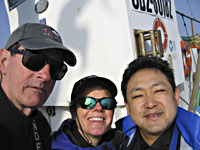
Chuck
Farwell, Tierney Thys and Nakatsubosan |
|
Expedition News—Japan
Mola Tagging April 2005
Plan
B saves the day
While
it may have been perfect timing for enjoying the serene profusion
of cherry blossoms in Japan, it was suboptimal timing for capturing
wild molas off the east coast.Nevertheless, our journey ended
in success—thanks to the advance preparation of our consistently
reliable friends at Kamogawa SeaWorld. Fortunately, back in March,
the Kamogawa staff had collected 3 molas, as a Plan B, just in
case the seas didn’t deliver during our April visit. Turns
out they were right to plan ahead as the seas held tightly to
their molas this trip.
Every year has presented different tagging challenges as well as
a fair share of good luck. In the first year, 2001, we deployed
3 tags in April and all of them reported. Fortunately, one tag
was retrieved by fishermen in the northern Aomori prefecture, sent
to Kamogawa SeaWorld, and returned back to us wherein we extracted
a complete and tremendously exciting data set. (Note: Retrieved
tags offer up an uncompressed dataset while tags that release from
the animal in the wild transmit their data only in compressed form.)
In 2003, we deployed 2 more tags that both reported additional
data and in 2004 one of our 3 deployed tags offered another dataset.
At present, we are putting the finishing touches on our manuscript
reporting the data from these tags.
|
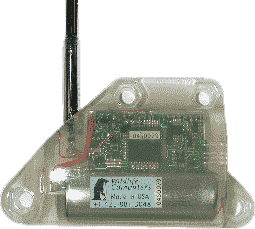
In
order to transmit, the SPOT must clear the water. This
means that only those marine animals exhibiting consistent
surface bouts are viable tag- toting candidates. Such
critters include marine mammals and turtles who must
come to the surface to breathe; some species of shark
that regularly slice the surface with their dorsal fins
and several species of fish like striped marlin that
stick part of their tail fins clear of the surface. We
figure the ocean sunfish, with its characteristic surface
basking behavior and habitat of flapping its dorsal fin
out of the water, particularly in the high latitudes,
is a prime candidate for SPOT toting.
SPOT tags have been successfully deployed on a number
of fish species including salmon sharks, blue sharks,
mako sharks and most recently striped marlin. Visit
the near real-time tracks from the Tagging of Pacific
Pelagics Project, part of the Census of Marine Life www.coml.org. http://las.pfeg.noaa.gov/TOPP/TOPP_tracks.html website
to see the exciting and fun tracks of these animals
(For more information on SPOT tags, see www.wildlifecomputer.com.) |
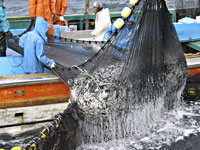
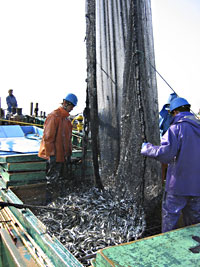
Harvesting the set nets full of anchovies
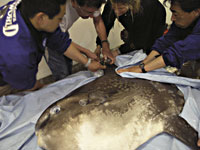
Affixing the SPOT to the mola

Transporting the mola from the holding tanks at
Kamogawa to the fishing boats

Releasing the mola to ply the waters and collect
data.

The magnificent fish hawks (black kites Milvus
migrans) that welcomed us back at the docks with open talons.
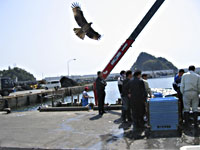
|
This
year (2005) in addition to deploying 2 more PAT tags, we decided
to try something new—a real-time tag--called a Satellite
Position Only Tag (SPOT). For details see sidebar.
As in past trips, our plan was to work with the fishermen of the
Kamogawa Fisheries Association to capture, tag and release wild molas
from set nets. Starting at 4:30 AM, we met with the head of the fisheries
operation, Mr. Sakamoto--a strapping 38 year old--who’s been
running this tight operation for upwards of 20 years. He and the
head of the fish market, Mr. Watanabe, welcomed us with big smiles,
black coffee and seaweed tea—like drinking a shot of hot ocean.
These fishermen and the Kamogawa SeaWorld staff have become like
family to us over these past years of working in Japan.
Sakamotosan
and Watanabesan shared with us the daily printout of the Kuroshio
Current location and temperature readings of the greater Kamogawa
coastal area. Turns out the water temperatures had been unseasonably
low for the past few days (13¾C) but were turning warmer since
our arrival (17¾C). After finishing our tea, we were off to the
boats in a flash.
Our
first day out, the fishermen discovered the main set net—the
one most likely to have molas--had torn substantially due to the
previous day’s fast currents, rendering the net out of commission
for at least 3 days. This left two set nets to sample. We headed
to the near shore net.
Watching
the harvest of these nets is quite an experience. Maneuvering a
complex maze of yellow buoys outlining the net boundaries, the
fishermen position 2 boats one across from each other to begin
their haul. As they lift the net section holding all the fish,
the water starts a slow dark boil. Hidden schools below press tightly
together and a confetti of glitter rises up from the depths—silent
sequins scraped from the skins of the panicked silvered swimmers
below. With each tug of the net, tail fins and fin flicks smash
and slice the surface frothing the water into silver white. A smaller
net is lowered in to scoop up the living silver bounty and purse
load after bulging purse load are pulled from the depths. Nothing
escapes.
Day
after day, the nets offered up large schools of anchovies and,
on one day, a tremendously rare school of more than 400 good-sized
yellowtail jacks, but no molas were to be found. With time running
out, we had to embrace plan B and accept Kamogawa SeaWorld’s
generous offer to use the molas they’d captured back in March.
With the staff’s expert assistance, we placed one SPOT tag
on the dorsal fin of their largest mola in the holding tank at
the aquarium. The great benefit of doing this bit of new tagging
on shore was that we could observe the tagged animal for two days
and record its acclimatization to the tag process. It responded
wonderfully well to its additional fin load. In fact, within just
a few minutes of tagging, it slurped down a tasty mixture of squid,
oysters, shrimp and tuna paste. For the remainder of our watch,
the SPOT tagged mola expressed normal swimming behavior and the
tag transmitted successfully each time the fish’s dorsal
fin cleared the water’s surface in the holding tank.
With
one day remaining, we transferred the SPOT tagged mola, along with
another mola, to two transport tanks, trucked them to the fishing
docks and transferred them both into a large live well on board
the fishing ship.
Then it was off to the release point offshore--as far as the fishermen
were willing to motor us away from their set nets. Right before
the release, we attached the two remaining PAT tags, took genetic
samples, measured total length and bid our little autonomous mola
vehicles bon voyage and sayonara.
Fingers
crossed the SPOT tag delivers!
Random
facts: Mola meat is selling for 500 yen/kg this year
while last year, with more animals around, it sold for 350 yen/kg.
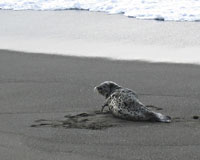
An
adorable spotted seal (Phoca largha) that showed up on
the beach the day we arrived. |
|

